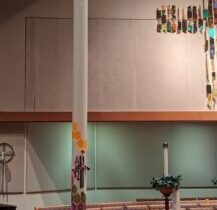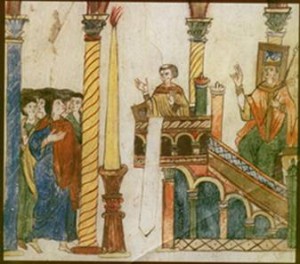What a beautiful night – Resurrection!
¡La noche de la resurrección!
It is a night that burns brighter than day. The darkness is banished by the light of love. Death is vanquished by the light of joy. Our fears have been taken away. Our crucified Lord is dead no more. The blinding light of the angel and the earthquake rolling away the stone stuns all of us.
En la madrugada las tinieblas moradas se rompen por el terremoto y el relámpago del ángel. Conmovidos, nos asustamos cuanto más al oír la consolación del ángel, “No temas.” Dios llega con su poder y gracia para rescatarnos. No temas.
Yet, the blinding light of the Angel’s voice tells us not to be afraid. We are shaken and our legs are trembling. But is this true? Yes! Our fear gives way to excitement. Go tell the others. You wept for him and anointed his body, torn and broken on the cross. You stayed with him until the end and now you have come to mourn him, but he is not here!
Al amanecer, la resurrección, se evanescen nuestros miedos, nuestras angustias, nuestra tristeza. Hemos visto el sufrimiento de los inocentes, hemos encontrado desconsolados la matanza de niños escolares. Hemos visto y tocado la fiebre del temor del COVID. No temas. Están sueltos de los lasos de la muerte como El Señor. Todo el sufrimiento de las cruces de la humanidad ha sido vencido por la cruz y resurrección del Salvador Victorioso.
Christ is victorious! Death has no power over him. Joined to him we have the promise of everlasting life. Heaven and earth are reconciled. With Him and in Him all glory, honor, and praise are given to the Almighty Father.
The forces of evil, despair, and distrust fell on Him and He vanquished them with compassion. “Father, they know not what they do.” In this priceless witness, the forces of derangement became only more furious. But He conquered them not by force but by coming forth from the sealed tomb.
Cristo en su triunfo ha vencido las fuerzas del pecado y furia por su humilde fe en la voluntad de su Padre. Lo captaron y crucificaron por su miedo, por su temor de que El los derribara de sus tronos y elevara a los humildes y mansos. Una luz resplandeciente que hace mover la tierra en sí misma nos ha amanecido en esa noche de nuestras velas de esperanza como estrellas en el domo del cielo.
Through the sin of Adam, a promise is made and fulfilled. God comes to pitch his tent with us. Light from light, True God from True God, begotten not made.
El cirio de la luz eterna rompe las cadenas de la oscuridad. La llama vacilante abofeteada por los vientos de nuestros tiempos, impulsados por la indiferencia, el enojo, y la desesperanza, la luz del cirio brilla aún más. Nos guía a través de las brisas de nuestra peregrinación, a través del Mar Rojo a pesar de nuestra duda. Anda en frente de nosotros por noche en el desierto desconocido y mostrándonos el camino al Padre.
“Go to Galilee.” “Go tell the others.” You will see him there. He is not here. But surely, He is here. We go to tell the others. Leaving our jars of spices and unguents to perfume the dead; leaving our wine and spices to wash the dead. We find him! We fall at his feet. He smiles and lifts us up. Go tell the others.
Mary of Magdala, relieved of seven devils by the Lord’s touch, weeps at the open tomb. His body has been stolen. Where have they taken him? The gardener must know. He must know. “Tell me sir, tell me where have they laid him?” So quietly, so gently, kindness meets my ears. “Mary!” He calls through my tears. The gardener tends a new paradise where sin cannot enter, nor ugliness, but only the sweetness of blossoms. “Mary!” I look up. “Rabboni, it is you!”
Nos da nueva vida el jardinero del paraíso. Su voz suave seca nuestras lágrimas. Con precaución levantamos nuestros corazones. ¿Puede ser? La tumba fue vacía. Ni sabemos por donde lo llevaron. Señor Jardinero, ¿sabe usted a dónde lo llevaron? y nos llama por nuestro propio nombre. ¡Cómo queremos quedarnos en este jardín de dulce alegría!
¿Sólo era en el pasado la tumba vacía?
The Angel tells tourists today, “He is not here.” We come with our phones and cameras, in our sandals and shorts. We are here to see the empty tomb. “Have you listened to the women and gone to Galilee?” the lightening voice asks. This is not history. This is your story. What are you going to do with this second chance? How will your sorrow be turned into joy? How will your smile conquer the frown in your heart? Is it enough to marvel at the paschal candle, the singing, the flowers and the lights? This holy night is only the beginning. On your way, as you leave the garden, pay heed to the Gardener to find your name and yourself.
Ya amanece el sol, Víctor de la madrugada. La estrella de la mañana surge en nuestros corazones. Cristo Rey victorioso, crucificado y muerto por las fuerzas de la maldad, triunfador resucitado desde la muerte llevando a nosotros consigo a la derecha del Padre.
Cristos Anesthe, Alethos Aneste, Christ is Risen, Truly Risen.
¡Viva Cristo Victorioso!
Readings for Easter Vigil– Lecturas para la Vigilia Pascual
Readings for Easter Sunday – Lecturas para Domingo de Pascuas
Read More














